World 🢖 Asia 🢖 India 🢖 Maharashtra
Buddhist shrines 🢔 Religious architecture 🢔 Archaeological wonders 🢔 Categories of wonders
Wonder
Ajanta Caves – rock cut Buddhist temples
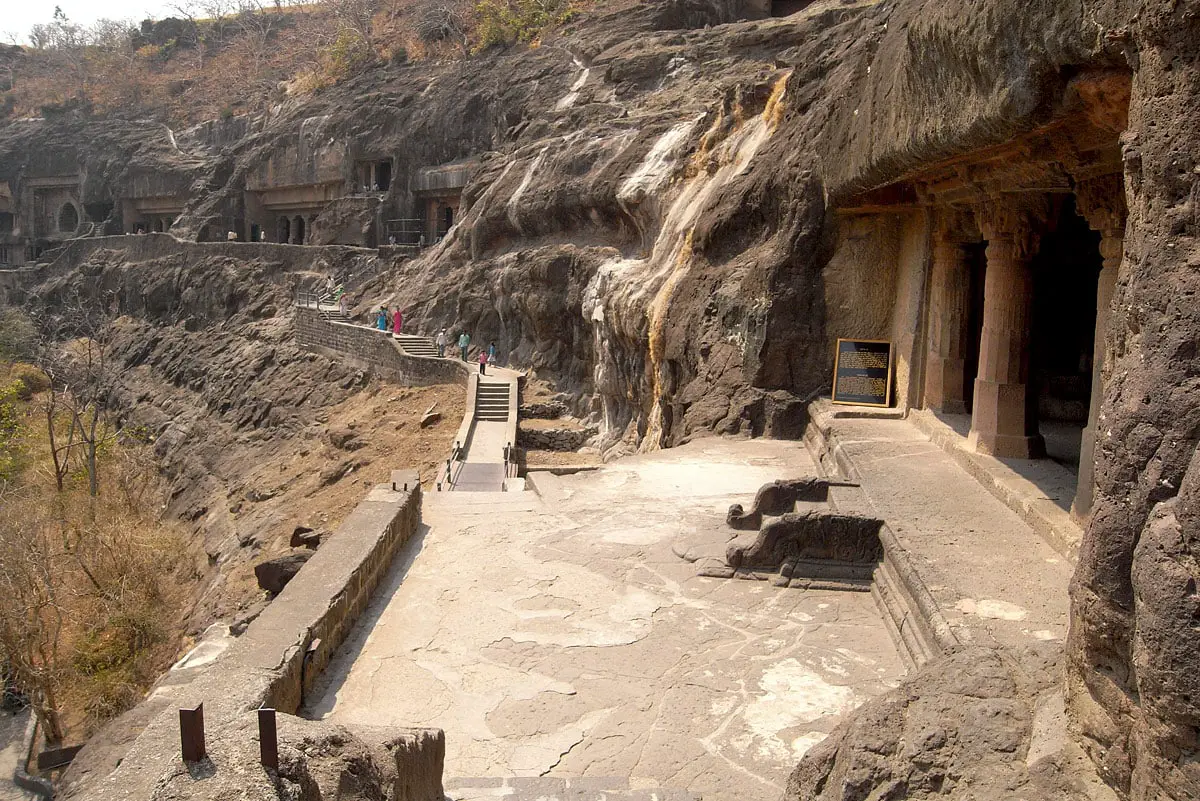
 In short
In short
Unique feature of Indian cultural heritage is rock-cut chambers – cave temples and monasteries. In total, we know more than 1,500 such temples spread out throughout the country. These temples contain an incomprehensible amount of art values – paintings, sculptures, inscriptions. Archaeological and historical investigations of this extremely rich heritage have taken many exciting years of numerous scientists but there still is almost endless work to be done.
 74.0%
74.0%
GPS coordinates
Location, address
Alternate transcriptions
Writing in Devanagari
Age
Religion
UNESCO World Heritage status
Map of the site
If you see this after your page is loaded completely, leafletJS files are missing.
 In detail
In detail
One of the best known and most impressive groups of cave temples is Ajanta Caves – these impressive structures serve as a popular tourist destination. These caves contain some of the richest collections of ancient art in the region.
Ajanta art inspired numerous artists of the late 19th – early 20th centuries. Many people were essentially obsessed with copying Ajanta paintings, there have been written numerous books about this phenomenal achievement of humanity.
Incredible accomplishment of ancient stonecutters
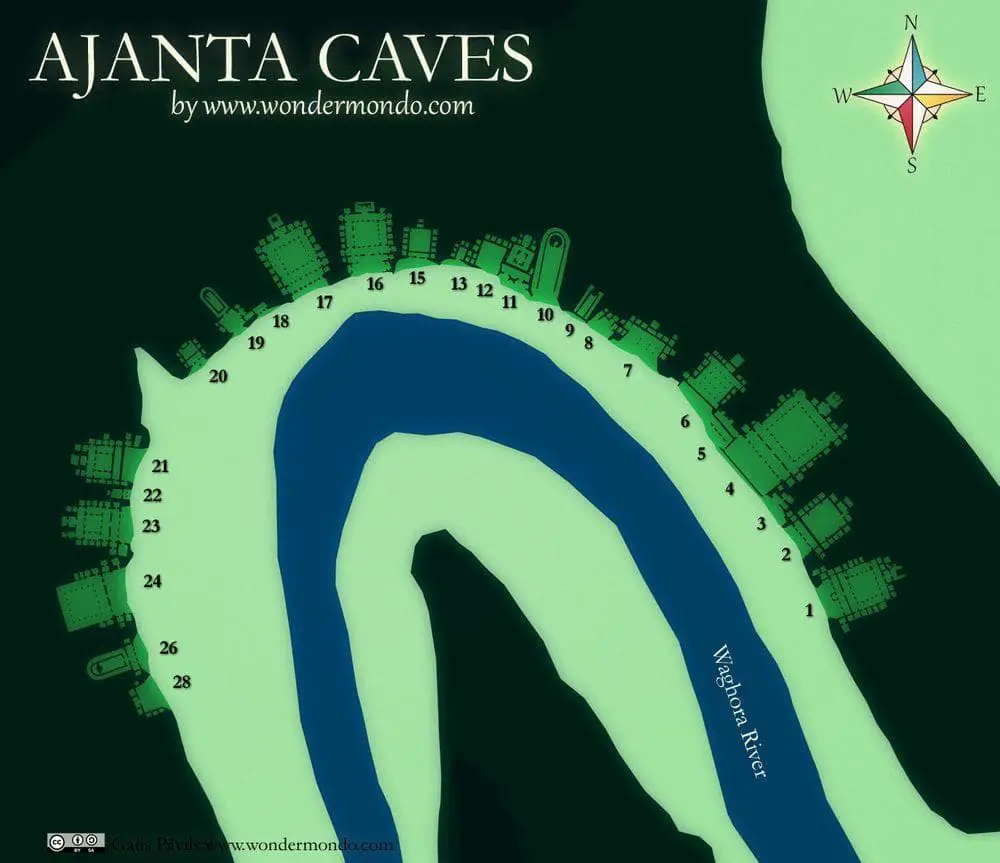
Ajanta Caves served as an extremely important religious center of Central Indian empires and, although located in a hard-to-access canyon, mirrored the political and social development of Central India.
First Buddhist caves in the vertical walls of the 75 meters deep (the vertical wall is not that high, this height includes talus) Waghora River canyon were created more than 2,000 years ago. During the Sātavāhana dynasty in the 2nd – 1st century BC early Buddhist monks did something that is hard to do even today – they managed to carve huge halls in the hard basalt rock of Deccan trap.
Zenith of Ajanta though came in 460 – 480 AD, during the Vakataka dynasty. Then Indian stonecutters had to master art which was almost forgotten. For three centuries there were not created cave temples in India. Thus numerous people had to learn these skills a hard way: by doing.
Cave chambers were not just rough hollows – stonecutters made whole interiors with columns, doorways, arched windows – everything was made by hollowing the solid rock as if it was cheese. Even more – up to 6 meters high columns, walls, ceilings were decorated with amazing bas-reliefs, often the flat walls were covered with beautiful, colorful murals.
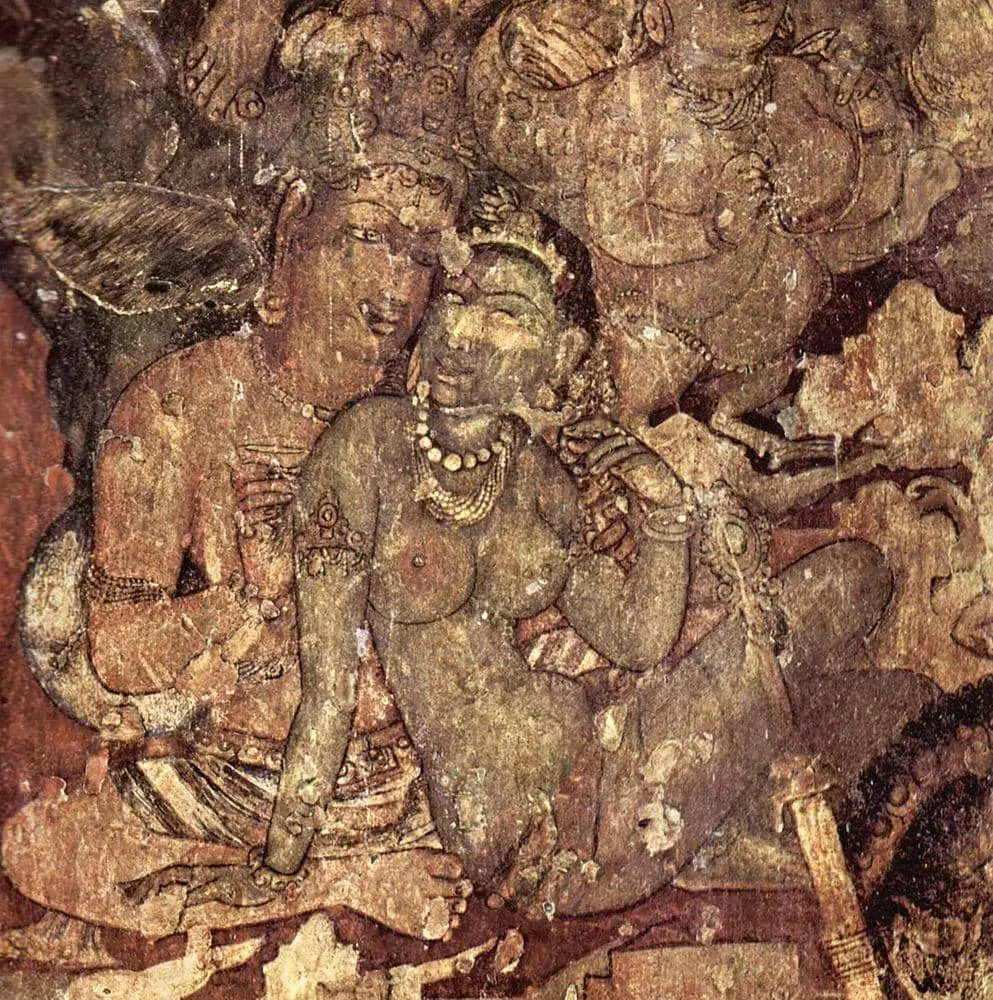
The layout was marked on the cliff face and the works started from above and went downwards until reaching the floor level. Basic work was done with sharp pick-axes, then the cliff face was leveled by hammer and chisel. This hard work was done with great precision. The largest spaces without support reach 21 x 15 meters – slightly smaller than the basketball field. But, if counting the supports, the halls are significantly larger – ancient stonecutters had quite good knowledge of structural engineering and with great skill planned the use of lintels and columns to create durable constructions.
Originally, caves were accessible by separate stairways from below, from the edge of the water. Nowadays access is much simpler – along the terrace there leads a road with nearly direct access to most cave temples.
Chaitya grihas and viharas
Caves No. 9, 10, 19, 26 are ancient sanctuaries – chaitya-grihas. Other caves though are created as monasteries – viharas.
Several chaitya-grihas are the most ancient monuments in Ajanta, for the most part, created in the 2nd – 1st century BC. They are characterized by a horseshoe-shaped bay above the doorway. Also: the central nave is divided from side aisles with a colonnade. Side aisles open in the apsis where was located stupa – reliquary. It was possible to go behind stupa – the rear wall in the plan is semicircular. Thus in several aspects, these ancient temples are similar to contemporary Christian churches.
Here, as it is seen in many ancient stone structures around the world, architecture is modeled after wooden architecture. Earlier structures were modeled after the simpler Hinayana cave temples.
20 viharas are newer – built during the years of ambitious patronage of Vakataka kings. The concept of construction of Buddhist temples underwent revolution sometime around 460 – 470 AD and as a result, the initially planned comparatively simple dormitories turned out to be complex sophisticated religious complexes. They included a shrine at the far end of the structure with a focus on the large Buddha statue. Sculpting Buddha was allowed comparatively recently and artists used the image of Buddha to show him present among the monks.
In many aspects the art in Ajanta symbolizes the golden age of ancient Indian culture, especially during the reign of Emperor Harishena of the Vakataka dynasty.
It seems that the simultaneous building of 20 viharas, each patrolled by separate influential authorities, raised rivalry among architects and artists, thus adding much splendor to Ajanta Caves.
Viharas of Ajanta belong to the most ornate and rich structures known from ancient times with numerous statues on facades and inside the structures.
Beautiful paintings and sculptures
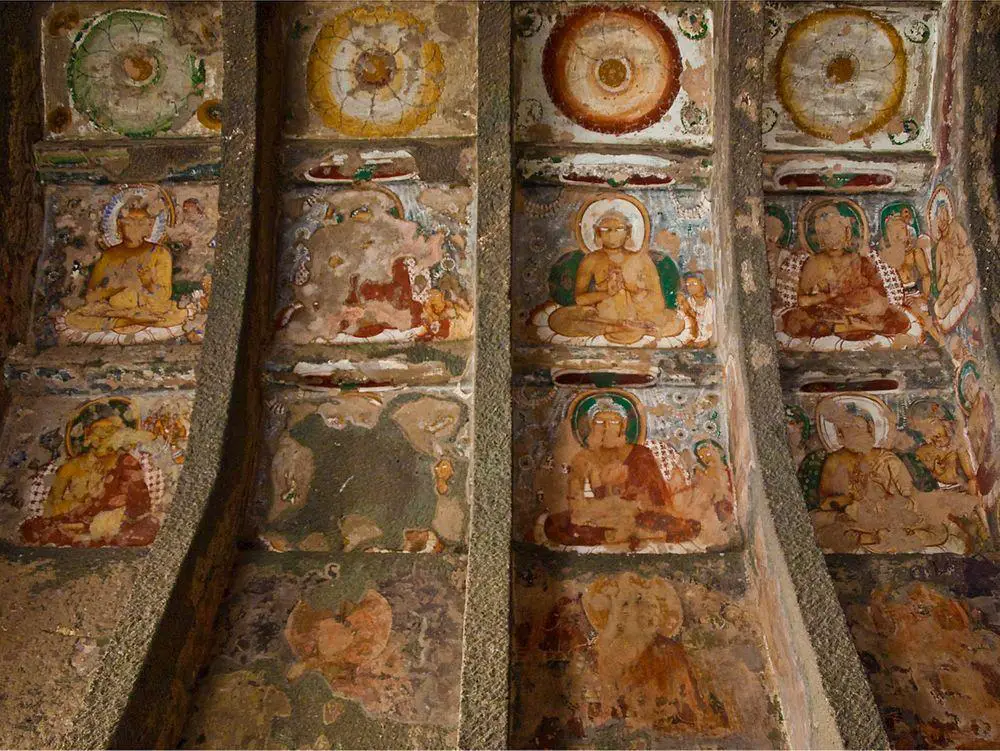
Several chambers of Ajanta contain some of the best paintings in Buddhist religious art. Ajanta contains also the oldest known Indian paintings from the 2nd century BC.
Paintings of Ajanta are frescoes. In Ajanta murals were made in a specific way, involving several stages of work. First, the surface was prepared – the stone surface was chiseled to make a rough surface holding the plaster. Then there was laid plaster consisting of clay, lime, hay, and dung. Paintings were made while the plaster was wet and colors were made of minerals and plants.
This technique allowed to make paintings that preserved much of their original glory even after 1,500 years of abandonment in the tropical climate.
Plastering was done by really skillful artisans – even some of the sculptures were plastered to get the effect of smoothness. Unusual shine was achieved by adding powdered conches and seashells – such polished plaster has a glassy surface.
Paintings of women in Ajanta are world-renowned – women in these drawings are beautiful. How else? Many of woman paintings and sculptures depict such mythical beings as yakshas, nagas, vrikshikas, river goddesses Ganga and Yamuna. Supernatural beauty is part of the essence of such beings.
Time is relentless – some paintings miraculously have survived but many things have changed. Statues of Buddha nowadays have a rugged, uncolored surface – but many centuries ago they most likely were smooth and covered with bright colors.
Sometimes it is mentioned that the painting technique in Ajanta is not fresco, it is mural. This is a somewhat confusing announcement – as if somebody would say that herring is not a herring but a fish. Fresco is characterized by the application of paint on wet plaster – thus ensuring a long life of colors. Exactly this was made in Ajanta. And finally – any fresco is a mural. Mural simply is painting on a wall, ceiling, or similar large surface.
Lost…
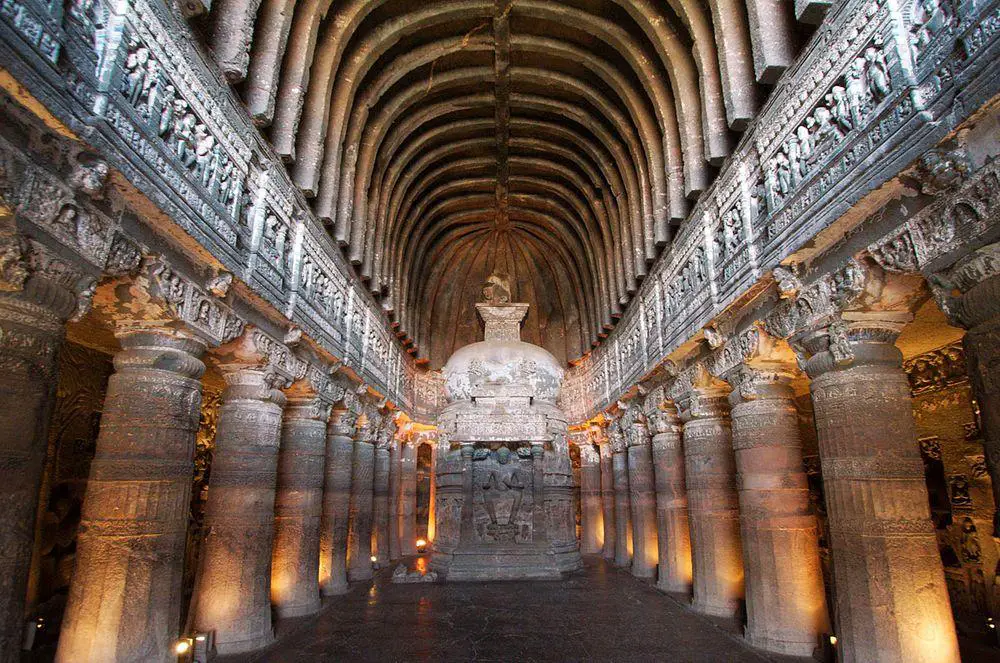
With the grandiose fall of the Vakataka empire sometimes around 480 AD Ajanta Caves were abandoned – within few months after the death of Harishena all the influential patrons of Ajanta Caves fled and Buddhist monasteries lost any support. Some of the paintings seem to be abandoned in a hurry – just a few hours were needed to make them ready, but some sudden events made further work impossible or useless.
The year of abandonment still is challenged by some scientists – some consider that temples were inhabited up to the 7th century AD, there is a report from Chinese pilgrim Hieun Tsang from the 7th century – he saw these monasteries full with life.
The forbidding canyon of Waghora River soon grew over with dense jungle. This might seem impossible – but the amazing, otherworldly beauty created and admired by many generations faded away from the memory of people. Once filled with life, beautiful caves were silent and undisturbed for approximately 1,100 – 1,300 years. Imagine… 1,300 years!
…and found again
Officer of the British army, captain John Smith was hunting a tiger on April 28, 1819. He followed the trail and entered the gorge. Back then the cliff walls were covered with dense vegetation – but the captain noticed a hollow through the interlaced roots and shoots.
Captain Smith left his name on the wall in this cave – this inscription still is faintly visible up to this day – out of reach now as the debris has been removed.
Description of caves – one by one
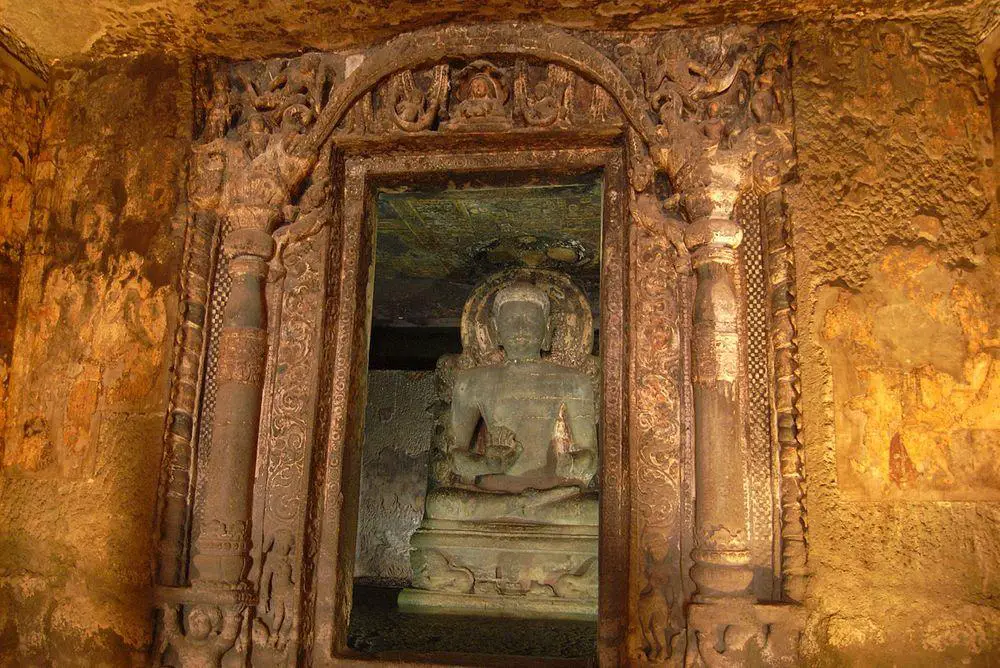
In total there are 29 – 30 cave chambers in Ajanta. Caves traditionally are numbered starting with the one closest to the village.
Cave 1 – royal vihara
One of the best-preserved cave chambers in the group, considered to be the most splendid Buddhist vihara in India. Possibly created to be an imperial cave of king Harishena. Paintings look fresh and are not damaged by soot – thus it is possible that this cave was not used by monks.
Some details though have perished such as portico with two pillars seen in photographs from the 19th century. The cave can be entered through three doorways, two windows are located between doorways.
The facade of the cave is adorned with elaborate, exquisite carvings depicting scenes from the life of Buddha. The porch still contains remnants of murals that once covered most of the spacious porch.
The main hall is some 6 m high with a shrine located at the rear wall. The shrine contains statues of seated Buddha. There are cells along the walls of the main hall.
Paintings are in a rather good state of conservation and belong to the best examples of ancient Indian art.
Cave 2 – vihara
This monastery building is even better preserved than Cave 1. Contains exquisite, well-preserved paintings on walls, ceilings, and pillars. The design of the porch differs from Cave 1, massive pillars are ornamented, walls are covered with murals depicting the life of Buddha in his former incarnations as Bodhisattva. Contains also smaller shrines to lesser deities.
This cave, in general, is very rich with paintings – in some areas well preserved, in others – nearly lost.
Cave 4 – vihara
The largest vihara in Ajanta Caves, created in the 5th century. Partly collapsed, most likely during the construction.
Inscription on the pedestal of Buddha in this vihara tells that the sculpture is a religious gift from a private person.
Cave 5 – vihara
Never completed – basically only porch, door and a short distance after the door have been made. Still, this cave contains beautiful sculptures.
Cave 6 – vihara
The only double-story structure in Ajanta Caves. The walls of this cave are covered with a thick layer of soot from incense and lamps, damaging the exquisite artwork. Diverse paintings include a figure of a devotee kneeling before Buddha.
Cave 7 – vihara
Intended as an enormous vihara but not completed. Only a very elaborate porch with few more details has been built. Exquisite paintings of the porch were lost due to smoke.
Cave 8 – vihara
An ancient structure which belongs to Hinayana school. Artisans created it in the 2nd – 1st century BC.
Cave 9 – sanctuary
Also, an ancient structure that belongs to the Hinayana school. The structure was created in the 2nd – 1st century BC. Contains ancient paintings which have been repainted at some later time. This is the cave that was discovered by Captain Smith in 1819 and it bears his inscription in pencil.
Cave 10 – sanctuary
The oldest (as far as archaeological knowledge about Ajanta goes) structure in Ajanta dating from the 2nd century BC, architecture testifies its belonging to Hinayana school. Contains ancient paintings which have been repainted at some later time.
Cave 11 – vihara
Possibly the oldest cave from the second period of Ajanta – from the 5th century.
Cave 12 – vihara
An ancient structure that belongs to Hinayana school. Ancient artists created it in the 2nd – 1st century BC.
Cave 13 – vihara
This is also an ancient structure that belongs to the Hinayana school. Artisans created it in the 2nd – 1st century BC.
Cave 14 – vihara
Made in the late 5th century, never completed. Basically, there is made a rough doorway with sculptures of yakshas.
Cave 15 – vihara
One more ancient structure, belonging to the Hinayana school, was created in the 2nd – 1st century BC.
Cave 16 – vihara
One of the best-placed caves in the middle of the complex. The cave chamber is adorned with beautiful paintings. Two elephant statues at the base of a stairway leading to the cave. The porch is damaged.
An inscription testifies that this cave is dedicated to the Buddhist Sangha by Vaharadeva, the influential prime minister of king Harishena (around 475-500 AD). There are numerous important inscriptions rising scientific discussion about the history of Central India in 460 – 480 AD.
Cave 17 – vihara
The richest collection of beautiful murals, especially ceiling. In many places, murals are damaged by soot from incense and lamps. An interesting accent is the depiction of an ancient Persian – Sassanian servant holding a Sassanian vessel on the left rear wall.
Inscription testifies that this structure is a gift of a prince in the time of king Harishena (around 475-500 AD).
Cave 18 – vihara
Initially, possible side shrine, part of Cave 19. Over time though developed as a cut-through between Cave 17 and Cave 19.
Cave 19 – sanctuary
Magnificent chaytia from the late 5th century. Contains remnants of paintings including depictions of Buddha considered to be innovative by some art historians. The facade of the porch is very rich with adornments.
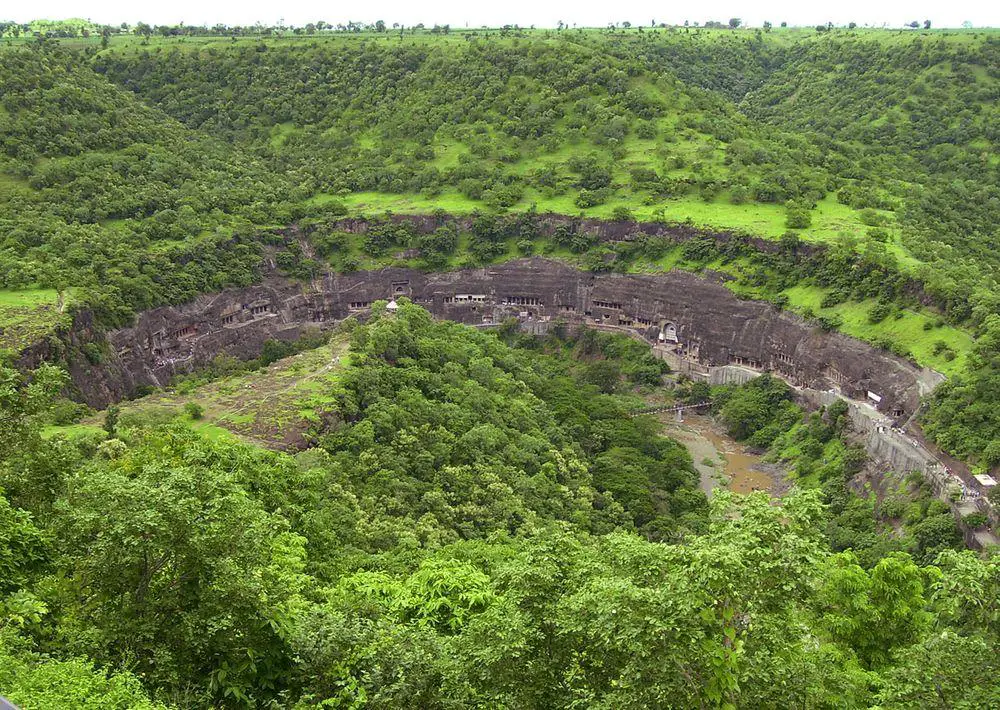
Cave 20 – vihara
Shrine from the 5th century AD. Contains an impressive stairway while the chamber has little interest to offer. The cave contains murals – including depictions of mundane joys such as hunting.
Cave 21 – vihara
The first cave behind a periodic waterfall. Vihara from the 5th century AD, unfinished. The porch is well adorned and preserved.
Cave 23 – vihara
Mostly unfinished, the porch though contains interesting figures.
Cave 24 – vihara
Mostly unfinished but the doorway is beautifully carved. Sculptures of two river goddesses on the upper corners of the doorway. It is calculated that approximately 200 people were working here when work unexpectedly terminated.
Cave 26 – sanctuary
Created in the late 5th century, a group of structures. Contains interesting drawings resembling a style of drawings at Ellora Caves. Porch adorned with numerous statues of Buddha as well as numerous other subjects. A famous sculptural group is the Parinirvana scene along the whole length of the cave.
Painting on the ceiling includes the usual lotus-lake motive, but here several geese are added among lotuses.
Cave 27 – vihara
Contains paintings at the right end of the front aisle as well as the inscription which informs that monk – painter here attained transcendental personage through painting images of Buddha.
Cave 29 – sanctuary
Here starts a fall of Vaghora River with seven cascades (sat-kund). The cave chamber is not finished, made in the 5th century.
References
- Ajanta Caves, description of monument for Advisory Body evaluation, UNESCO World Heritage Centre, 1983
- Ajanta Caves, report on state of conservation, UNESCO World Heritage Centre, 2003
- Ajanta: History and Development. Walter M. Spink 2005
- The art of Ajanta & Sopoćani. Om D. Upadhya, Udaipur 1994
Ajanta Caves are included in the following lists and articles:
 Linked articles
Linked articles

Wonders of India
India is the seventh-largest country in the world by area, and, naturally, such a large area contains a huge amount of exciting attractions…
Wondermondo considers that India is the second richest center of architectural heritage in the world after Europe and maybe no single country in the world can match it in this respect.
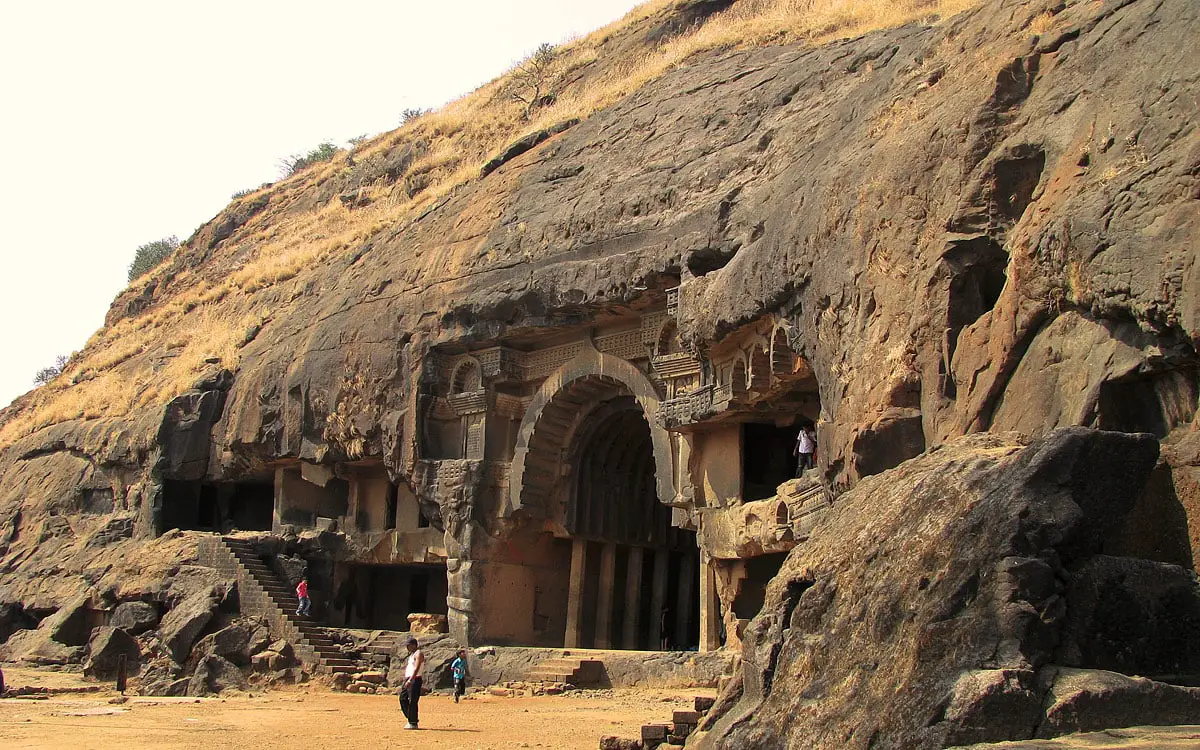
Rock-cut architecture and sculptures
Rock-cut architecture is a very ancient form of architecture – the oldest structures are more than 5 thousand years old. The resistivity of the natural stone and the constant climate inside these structures has preserved many art values around the world.

Buddhist shrines
Buddhism is one of the world religions and at the same time is a spiritual philosophy with diverse traditions, beliefs, and practices. There exists a rich tradition of architecture expressed in Buddhist temples and monasteries.
 Recommended books
Recommended books
The Ajanta Caves: Ancient Paintings of Buddhist India
A potent and beautiful symbol of India’s rich artistic past and a major treasury of Buddhist art. In 1819, a group of British soldiers on a hunting expedition chanced upon the Ajanta caves some 200 miles northeast of Bombay. Ranging in date from the second century BC to the sixth century AD, the exquisite Buddhist paintings and sculptures found there now rank among the world’s most important cultural treasures. The murals were created using only the glow of lamps and candles, quite unlike the harsh light employed in modern professional photography.
An Introduction to the Ajanta Caves: With Examples of Six Caves
This is the most up-to-date book on the art, architecture, and history of the famous Ajanta caves. It includes chapters on political background, religious background, and epigraphy. It includes a summary of the latest research carried out in the last few decades. It brings together critical information from scholarly books and periodicals.


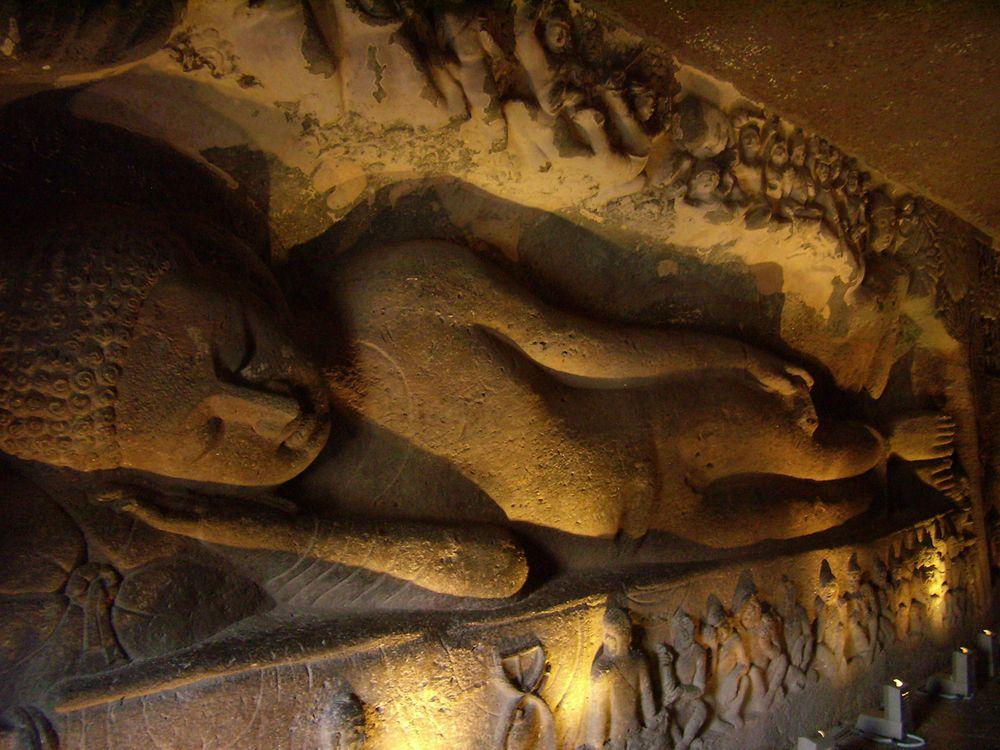
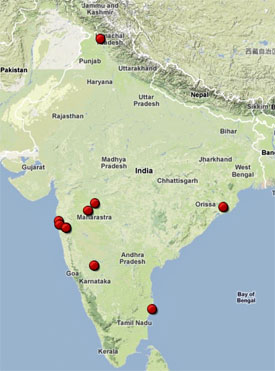
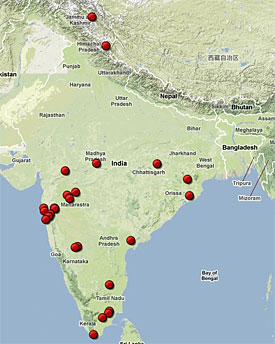


Greate pіeces. Keep posting such kind off info on your site.
Im really impressed by it.
Hello there, You һaᴠe pervormed a fantastic joЬ. I wikll certainly digg it and in my opini᧐n suggest to my friends.
I’m sure they will be bnefiteԁ from this site.
Tanks, I will continue! Just a little bit of technicalities, while adjusting the website to the new code platform.
Ajanta caves wikipedia not three or four lines of ajanta cave _by_cave
There are also large books about Ajanta with hundreds of pages. Should this website beat all of them as well? 🙂